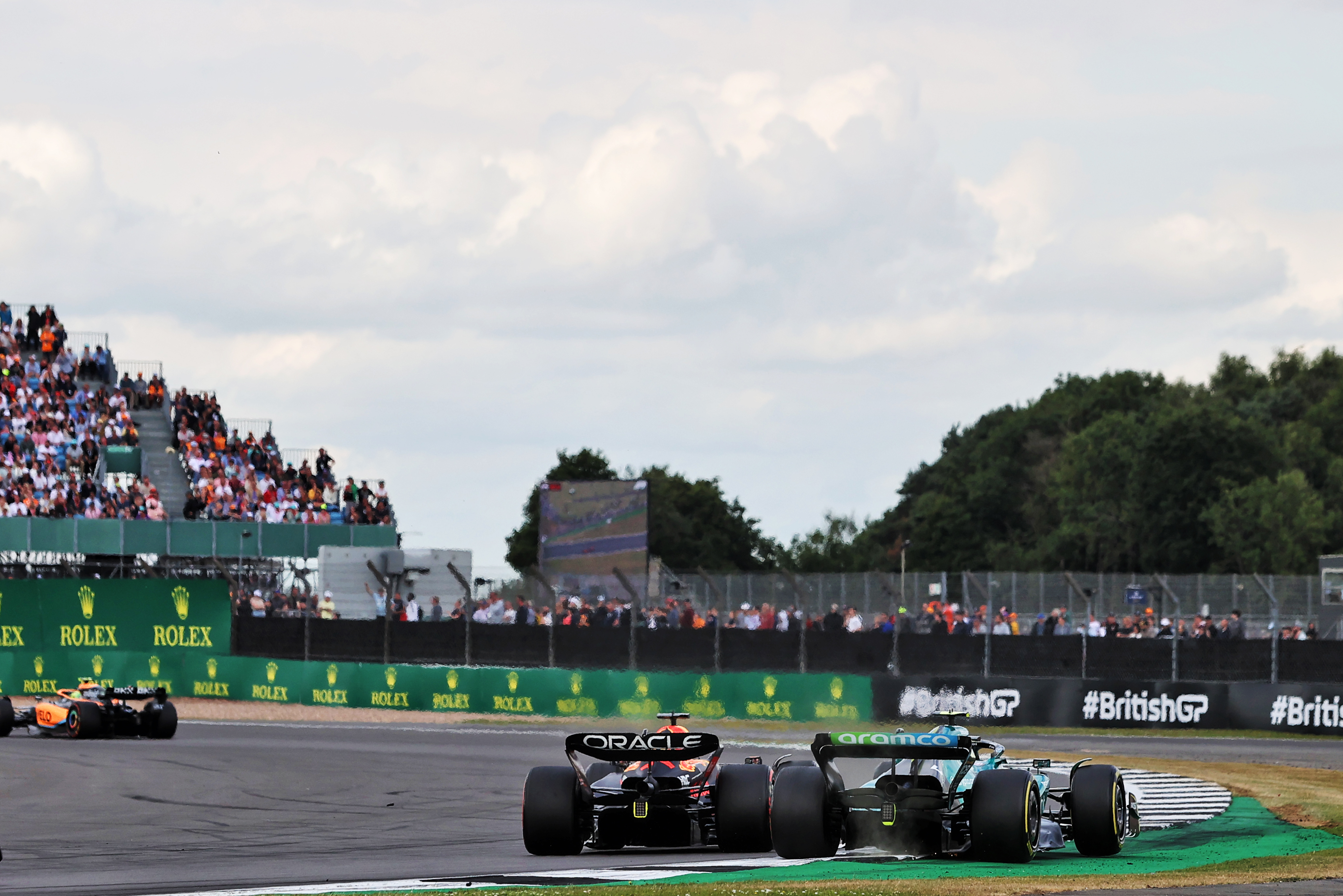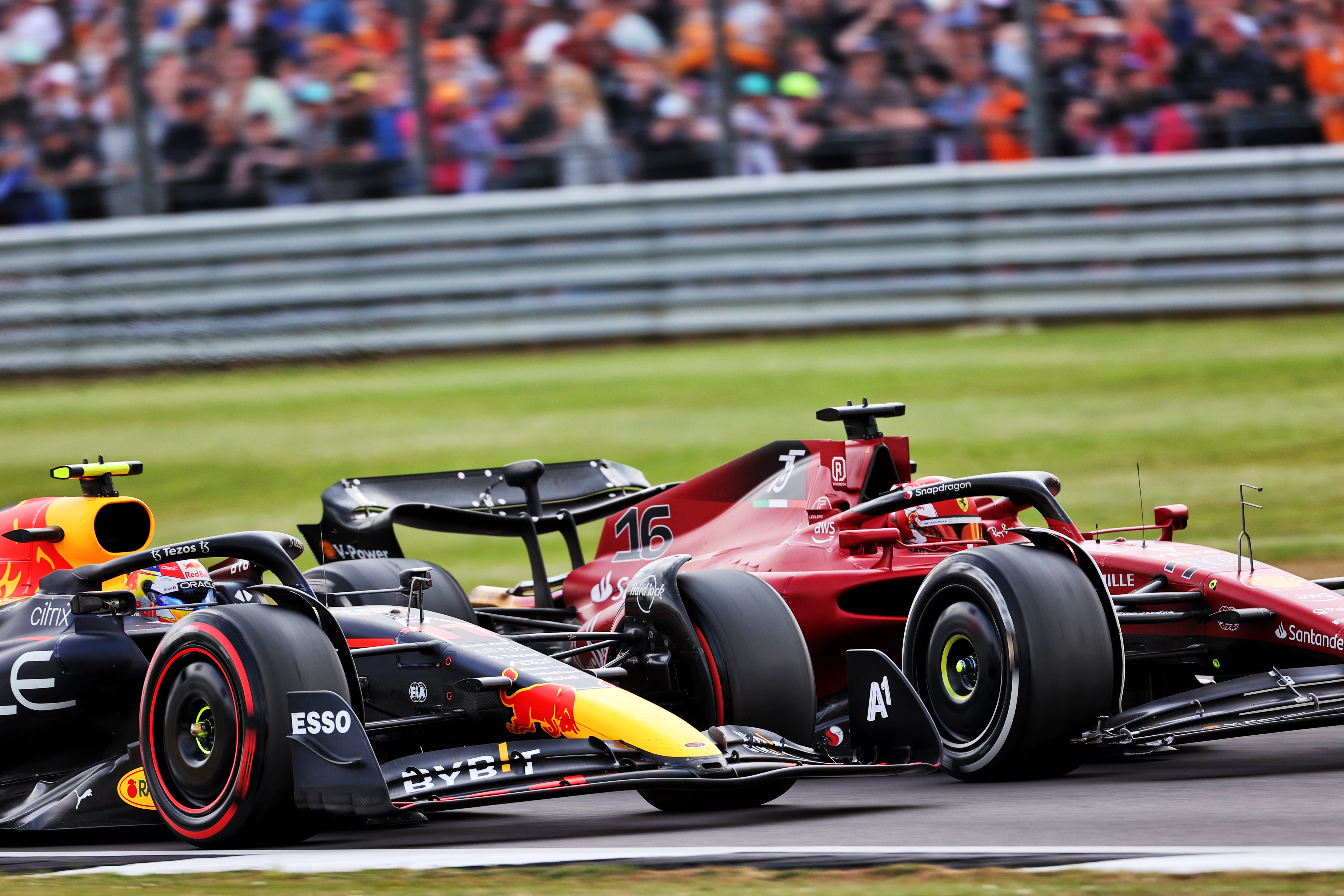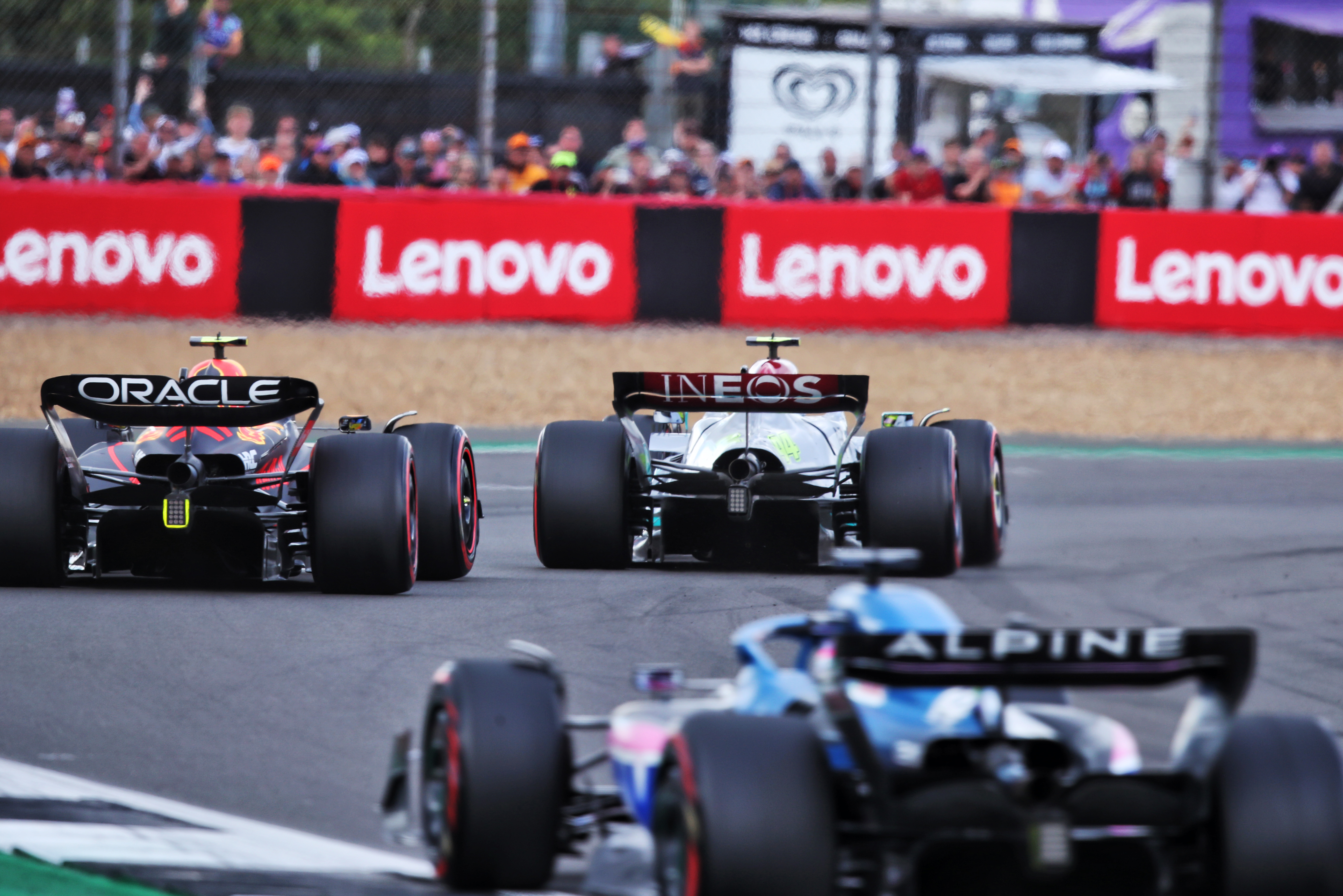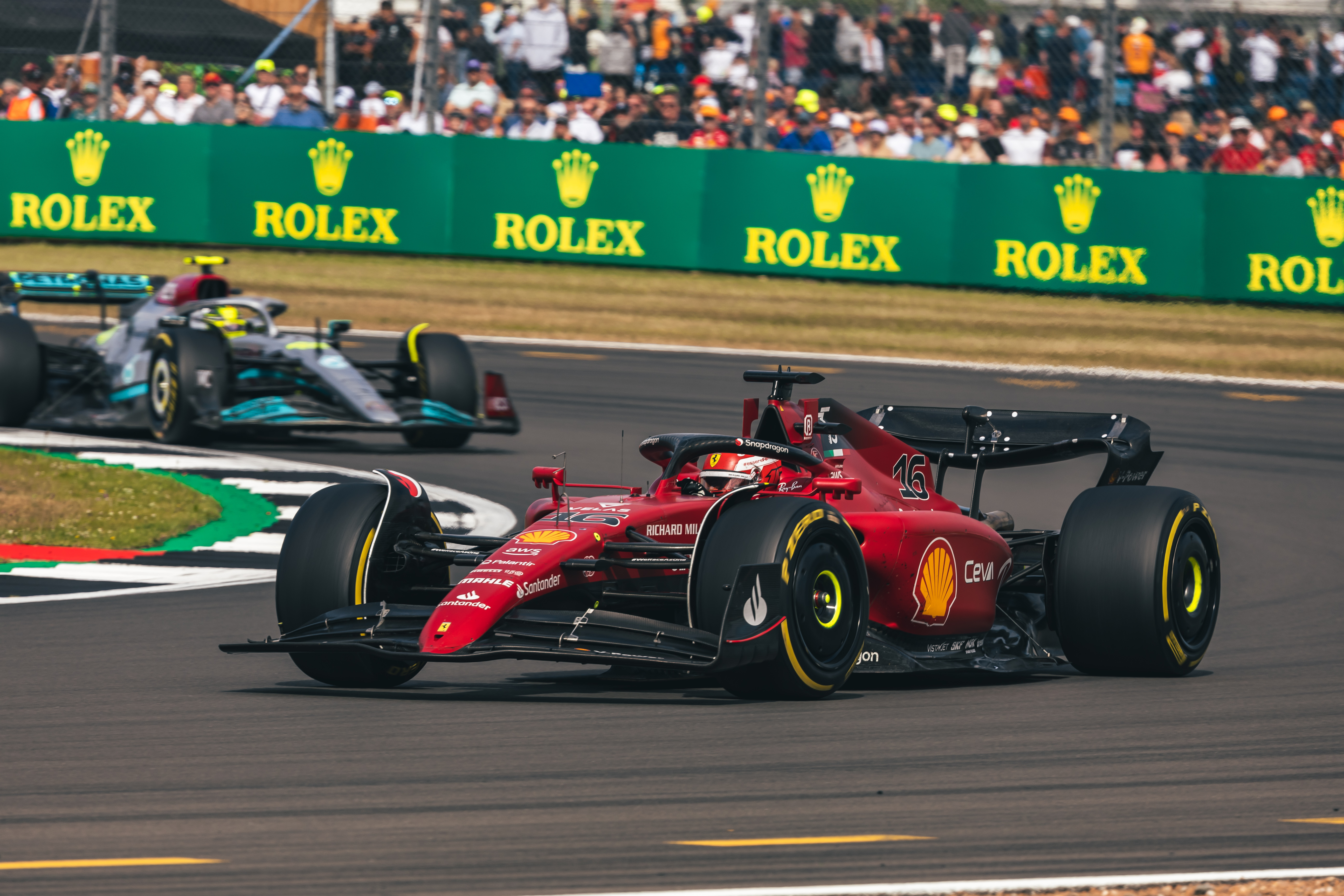After a series of controversies last year between title rivals Max Verstappen and Lewis Hamilton, Formula 1 rulemakers introduced new racing guidelines for 2022.
These were tested, arguably for the first time in earnest, in last weekend’s British Grand Prix – and on multiple occasions by Verstappen alone.
Four times Verstappen ran another driver out of road on the exit of a corner, a move also used by Red Bull team-mate Sergio Perez, Hamilton, and Verstappen’s 2022 championship rival Charles Leclerc.
Some of these seemed more egregious than others, but none received a penalty. None were even fully investigated. And in most of these incidents of a driver not leaving any room for their opponent, the best case for why it was allowed is that the new guidance seems to permit a driver to ignore the International Sporting Code.
At the start of this year the FIA said if a driver is overtaking on the inside of a corner, they must “have a significant portion of the car alongside” to be given space. There are “various factors” that will determine what it is a “significant portion” but one that is specified is whether their front tyres are alongside the other car by “no later than the apex of the corner”. The car overtaking on the inside must also “clearly remain within the limits of the track” – but nothing is specified for the car being overtaken.
As for overtaking on the outside of a corner, once again the driver attempting the move must have a “significant portion” of their car alongside. In this scenario, though, the stewards will consider if the overtaking car is “ahead of the other car from the apex of the corner”. And in this case, both cars must be able to make the corner while remaining “within the limits of the track”.
Verstappen tested both versions of the guidance in the British GP – two moves by him on the inside, two attempted moves by others on him on the outside. So let’s take a look, starting with the two obvious and most widely talked about ones.
VERSTAPPEN vs LECLERC
Leclerc tries to pass on the outside

At the second race start, Verstappen lost momentum behind Sainz exiting The Loop and Leclerc used the tow down the Wellington Straight to attack into Brooklands.
This incident actually highlighted an interesting factor within the guidelines – what difference does a late apex like the one at Brooklands make? Do you judge it geometrically (mid-corner) or racing line (slightly later around the inside kerb)?
If it’s the former then Leclerc could argue he was ahead. He came from behind under braking and actually nosed in front as they entered the corner wheel-to-wheel. Then Verstappen took control of the corner, got his wheels in front, and brutally forced Leclerc aside.
Leclerc was shoved onto the run-off but crucially, Verstappen just kept part of his inside wheels on-track (defined by the white line). This ensured the move remained legal.
VERSTAPPEN vs SCHUMACHER
Schumacher tries to pass on the outside

Mick Schumacher attacked Verstappen on the final lap of the grand prix to try to take seventh. He had an excellent run down the Wellington Straight and tried to pass Verstappen around the outside at Brooklands. But Verstappen covered the inside and Schumacher never nosed ahead, not even quite managing to get alongside under braking. With Verstappen clearly in front at the apex he let the car run wide on exit and crowded Schumacher onto the run-off.
At the end of the lap, Schumacher tried to get past Verstappen on the inside of the final corner, the flat-out right kink at the end of the Club complex. Verstappen left some room but nowhere near a car’s width and Schumacher backed out to avoid contact. Of that, Verstappen said: “I was like, ‘well, he has to now back off, otherwise we’re both out’. But he’s smart enough to think.”
There are two key points to consider here. First is that the fact these guidelines lay out what is necessary “for a car being overtaken to be required to give sufficient room” – so the obvious conclusion is that, because neither Leclerc and Schumacher got ahead of Verstappen by the apex, he was not required to give sufficient room.
The second point is how this fits with the ISC. The code specifies that “deliberate crowding of a car beyond the edge of the track” is prohibited. So, do the new 2022 guidelines mean that what Verstappen did at Silverstone is not considered deliberate crowding? Or is this a contradiction – one rule (the ISC) saying cars shouldn’t be crowded off-track and a guideline (the race director’s instructions) implying that anything could be fair game depending on the positioning of the cars?
Either way, how you square the wording of the ISC with these 2022 guidelines is crucial to defining what counts as “deliberate crowding”. And now we have a precedent that sweeping to the edge of the circuit – whether it’s the natural racing line or not – to block off your opponent on the outside is OK, as long as you were ahead at the apex.
But all of this only relates to incidents where the car on the outside is trying to overtake. What about overtaking on the inside – can you crowd the car on the exit of the corner then?
VERSTAPPEN vs MAGNUSSEN
Verstappen passes on the inside

When the race restarted following a safety car, Verstappen passed Magnussen into Brooklands. He had a good run on the Haas exiting The Loop and was clearly ahead at the apex of the corner. Magnussen conceded the entry and Verstappen was almost completely ahead mid-corner, with Magnussen’s front-left wheel just level with Verstappen’s rear right.
But Magnussen tried to hang on around the outside and come back at Verstappen in the second half of the corner into Luffield. Verstappen, though, crowded him off the track by running right up to the white line.
VERSTAPPEN vs VETTEL
Verstappen passes on the inside

One lap after passing Magnussen, Verstappen set his sights on Vettel. Though Vettel covered the inside into Village he left the door open into The Loop, which Verstappen took advantage of. He dived inside Vettel and ran his car close to the edge of the track again, not all the way but enough for Vettel to be crowded over the exit kerb.
Interestingly, earlier in the race Vettel had passed Verstappen around the outside at Village cleanly. Verstappen was exiting the pits on hard tyres and was warned it would be close, and was aware Vettel was there as he covered the middle of the track. But Vettel, with his tyres at racing temperature, was able to brake later to carry more speed around the outside, and Verstappen left more than enough room for the move to be completed.
The guidelines imply these were permitted because unlike overtaking on the outside, there is no specific reference to the car being overtaken having to stay on the track. So, presumably, this doesn’t count as “crowding” as mentioned in the ISC – it’s just that the car on the outside is not entitled room because it was not level or ahead mid-corner.
If this is an incorrect interpretation of the rules, then why did these two Verstappen moves go unpunished? It either was crowding, or it wasn’t. But again, there’s an apparent contradiction between what the ISC says and what the guidelines imply.
The case studies from Silverstone suggest a reversion to the long-applied, if unwritten, rule that, regardless of who is doing the overtaking, a car on the inside has the right to crowd the car on the outside on exit as long as they are ahead and can ‘claim’ the corner.
Hard, yes. Unfair, maybe – but not traditionally and, according to these precedents from Silverstone, not now.
This will probably be less contentious at some tracks than others but part of the reason it was so obvious and so significant at Silverstone is that in all the above incidents, the driver being crowded out was prevented from coming back at their rival. And Silverstone’s layout is fantastic for drivers trading blows and fighting corner-to-corner.
The Village-Loop combination, Brooklands-Luffield, and even Stowe-Club make for superb sequences of battling. Being allowed to crowd a rival off-track kills the battle dead, as we saw in several other moments not involving Verstappen.
THREE OTHER FLASHPOINTS
LECLERC vs PEREZ
Wheel-to-wheel fighting through three corners

A mighty three-car fight between Leclerc, Perez and Hamilton was one of the highlights of the grand prix as Leclerc’s bold effort to hang on to a podium against cars on much better tyres played out. This battle pushed the limits and probably exceeded them.
It peaked when Perez launched a move on the inside at Stowe but Leclerc hung on around the outside and then repassed him into the start of the Vale/Club complex. Leclerc left almost a car’s width room on the inside but Perez, presumably expecting that gap to close, pre-emptively opted to cut the corner.
As he ran wide, Leclerc took to the run-off on the exit – again, presumably pre-emptively expecting to be crowded out. Perez went off-track and gained an advantage. No explanation for why this was permitted has been given, although both cars going off-track in quick succession and the fact neither seemed to leave a full car’s width for each other may have contributed to it being shrugged off with the desire to ‘let them race’.
PEREZ vs HAMILTON
Perez passes Hamilton on the inside

The above battle allowed Hamilton to sweep past both on the exit of Club and briefly take third, but Perez fought back instantly. Hamilton failed to defend sufficiently at Village and Perez outbraked him on the inside. He was clearly ahead at the apex although on a very tight line, which inevitably led to him running wide on exit – although he released a small amount of steering lock, most of Perez’s car position was defined by the angle and speed on entry. Much like Magnussen vs Verstappen, Hamilton attempted to go through the corner side-by-side and use his wider line to take more speed through the second half of the corner. But unlike when Verstappen allowed Vettel to pass him in that way earlier in the grand prix, Perez didn’t leave enough space to do that.
HAMILTON vs LECLERC
Leclerc tries to pass Hamilton on the outside

Hamilton jumped Leclerc at the original start and then took a defensive line into Turn 3. Leclerc went to the outside but was behind Hamilton and barely had his front right wheel alongside Hamilton’s left rear at the apex. Hamilton did not let his car run right to the edge of the track on the exit but did not leave a car’s width either. He was likely not required to given how far behind Leclerc was mid-corner and the fact it was the first lap, which is generally viewed differently, probably helped as well.
It’s worth understanding that the guidelines do still leave each incident to the discretion of the stewards. And they are vague. For instance, at what point mid-battle do the stewards switch from applying the rules governing a car overtaking on the inside to the rules governing a car overtaking on the outside?
Take the Verstappen/Magnussen and Perez/Hamilton incidents. Those moves started with a car trying to pass on the inside. But the profile of the corner encouraged the car on the outside to hang on around the outside. Do the stewards consider this one move? Or is there a point where they consider the car on the inside has conducted itself appropriately and the car coming back on the outside is now the aggressor, so the rules shift?
Either way, running cars wide on exit was an obvious theme of the British GP. It has long been a dark art of racing and, based on this precedent, appears to be enshrined in the 2022 racing rules.
Verstappen may be the most adept at exploiting that, given it fits with his aggressive and uncompromising approach, but he is not the only one.
Other drivers will need to take this into account if the rules remain the same – although based on some other case studies from Silverstone, some already have.


